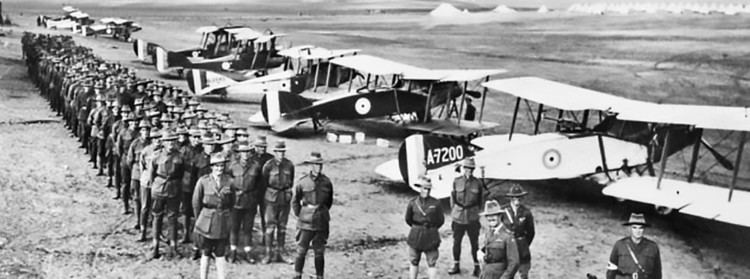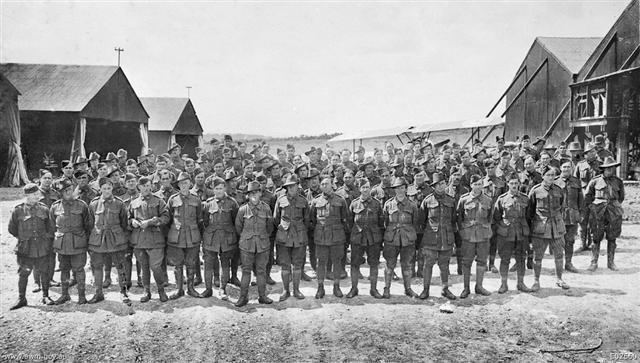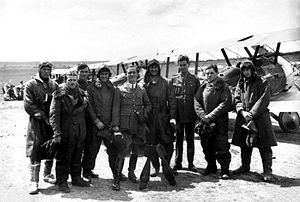Active 1912–21 | Country Australia | |
 | ||
Notablecommanders Edgar ReynoldsRichard Williams Similar Royal Flying Corps, First Australian Imperial F, Canadian Air Force, Imperial Russian Air Service, Imperial and Royal Aviation T | ||
Ww1 afc australian flying corps
The Australian Flying Corps (AFC) was the branch of the Australian Army responsible for operating aircraft during World War I, and the forerunner of the Royal Australian Air Force (RAAF). The AFC was established in 1912, though it was not until 1914 that it began flight training.
Contents
- Ww1 afc australian flying corps
- Establishment
- Operations
- Organisation
- Personnel
- Equipment
- Training
- Post war legacy
- References

In 1911, at the Imperial Conference held in London it was decided that aviation should be developed by the various national armed forces of the British Empire. Australia became the first member of the Empire to follow this policy. By the end of 1911, the Army was advertising for pilots and mechanics. During 1912 pilots and mechanics were appointed, aircraft were ordered, the site of a flying school had been chosen and the first squadron was officially raised. On 7 March 1913, the government officially announced formation of the Central Flying School (CFS) and an "Australian Aviation Corps", although that name was never widely used.

Units were formed for service overseas with the Australian Imperial Force (AIF) during World War I. They saw action, initially, in the Mesopotamian Campaign. The AFC later saw action in Palestine and France. In addition, a training wing was established in the United Kingdom. The corps remained part of the Australian Army until 1921, when it was re-established as the independent RAAF.

Establishment

On 30 December 1911, the Commonwealth Gazette announced that the Australian military would seek the "...appointment of two competent Mechanists [sic] and Aviators", adding that the government would "accept no liability for accidents". On 3 July 1912, the first "flying machines" were ordered: two Royal Aircraft Factory B.E.2 two seat tractor biplanes and two British-built Deperdussin single seat tractor monoplanes. Soon afterward, two pilots were appointed: Henry Petre (6 August) and Eric Harrison (11 August).

On 22 September 1912, the Minister of Defence, Senator George Pearce, officially approved formation of an Australian military air arm. Petre rejected a suggestion by Captain Oswald Watt that a Central Flying School be established in Canberra, near the Royal Military College, Duntroon, because it was too high above sea level. Petre instead recommended several sites in Victoria and one of these was chosen, at Point Cook, Victoria, on 22 October 1912. Two days later, on 24 October 1912, the government authorised the raising of a single squadron. Upon establishment the squadron would be equipped with four aircraft and manned by "...four officers, seven warrant officers and sergeants, and 32 mechanics" who would be drawn from volunteers already serving in the Citizen Forces.

On 7 March 1913, the government officially announced formation of the Central Flying School (CFS) and the "Australian Aviation Corps". According to the Australian War Memorial, the name "Australian Flying Corps does not appear to have been promulgated officially but seems to have been derived from the term Australian Aviation Corps. The first mention of an Australian Flying Corps appears in Military Orders of 1914." Flying training did not begin immediately, though, and it was not until 1914, that the first class of pilots were accepted. No. 1 Flight of the Australian Flying Corps was raised in the 3rd Military District on 14 July 1914.
In March 1914, a staff officer, Major Edgar Reynolds, was officially appointed General Staff Officer in charge of a branch covering "intelligence, censorship, and aviation" within the Army's Department of Military Operations. Following the outbreak of World War I and the expansion of the Army, aviation later became a separate branch commanded by Reynolds. However, during the war, AFC operational units were attached and subordinate to Australian ground forces and/or British ground and air commands. Reynolds' role was mostly administrative rather than one that involved operational command.
Operations
After the outbreak of war in 1914, the Australian Flying Corps sent one aircraft, a B.E.2, to assist in capturing the German colonies in northern New Guinea and the Solomon Islands. However, German forces in the Pacific surrendered quickly, before the plane was even unpacked from its shipping crate.
The first operational flights did not occur until 27 May 1915, when the Mesopotamian Half Flight (MHF), under the command of Captain Henry Petre, was called upon to assist the Indian Army in protecting British oil interests in what is now Iraq. Operating a mixture of aircraft including Caudrons, Maurice Farman Shorthorns, Maurice Farman Longhorns and Martinsydes, the MHF initially undertook unarmed reconnaissance operations, before undertaking light bombing operations later in the year after being attached to No. 30 Squadron RFC. Losses were high and by December, after flying supplies to the besieged garrison at Kut, the MHF was disbanded.
In January 1916, No. 1 Squadron was raised at Point Cook in response to a British request for Australia to raise a full squadron to serve as part of the RFC. Reynolds served as the squadron's commanding officer, prior to its embarkation for overseas service. The squadron, consisting of 12 aircraft organised into three flights, arrived in Egypt in April and was subsequently assigned to the RFC's 5th Wing. In mid-June it began operations against Ottoman Empire (Turkish) and Senussi Arab forces in Egypt and Palestine. It would remain in the Middle East until the end of the war, being reassigned to No. 40 Wing in October 1917, undertaking reconnaissance, ground liaison and close air support operations as the British Empire forces advanced into Syria, initially flying a mixture of aircraft including B.E.2cs, Martinsyde G.100s, B.E.12as and R.E.8s – but later standardising on Bristol Fighters. One of the squadron's pilots, Lieutenant Frank McNamara, received the only Victoria Cross awarded to an Australian airman during the war, receiving the award for rescuing a fellow pilot who had been downed behind Turkish lines in early 1917. No. 1 Squadron was credited with the destruction of 29 enemy aircraft.
Three other squadrons – No. 2, No. 3 and No. 4 – were raised in 1917 in Egypt or Australia, and were sent to France. Arriving there between August and December, these squadrons subsequently undertook operations under the operational command of British Royal Flying Corps (RFC) wings along the Western Front. No. 2 Squadron, under the command of Major Oswald Watt, who had previously served in the French Foreign Legion, was the first AFC unit to see action in Europe. Flying DH.5 fighters, the squadron made its debut around St Quentin, fighting a short action with a German patrol and suffering the loss of one aircraft forced down. The following month the squadron took part in the Battle of Cambrai, flying on combat air patrols, and bombing and strafing missions in support of the British Third Army, suffering heavy losses in dangerous low-level attacks that later received high praise from General Hugh Trenchard, commander of the RFC. The squadron's DH.5s were replaced with superior S.E.5a fighters in December 1917, with which the squadron resumed operations shortly afterwards. Operating R.E.8 reconnaissance aircraft, No. 3 Squadron entered the war during final phase of the Battle of Passchendaele, also in November, during which they were employed largely as artillery spotters. No.4 Squadron entered the fighting last. Equipped with Sopwith Camels, the squadron was dispatched to a quiet sector around Lens initially and did not see combat until January 1918.
During the final Allied offensive that eventually brought an end to the war – the Hundred Days Offensive – the AFC squadrons flew reconnaissance and observation missions around Amiens in August, as well as launching raids around Ypres, Arras and Lille. Operations continued until the end of the war, with some of the fiercest air-to-air fighting coming on 29 October, when 15 Sopwith Snipes from No. 4 Squadron fought an engagement with a group of Fokkers that outnumbered them four to one. In the ensuing fighting, the Australians shot down 10 German aircraft for the loss of just one of their own. During their time along the Western Front, the two fighter squadrons – No. 2 and 4 – accounted for 384 German aircraft, with No. 4 credited with 199 and No. 2 shooting down 185. In addition, 33 enemy balloons were destroyed or driven down. Meanwhile, No. 3 Squadron, operating in the corps reconnaissance role, accounted for another 51 aircraft.
Organisation
By the end of the war, four squadrons had seen active service, operating alongside and under British Royal Flying Corps (and in 1918 the Royal Air Force) command. For administrative reasons, and to avoid confusion with similarly numbered RFC units, at one stage each AFC squadron was allocated an RFC number – the Australians themselves never used these numbers, and in the end, to avoid further confusion, the original AFC numbers were reinstated. The four operational squadrons of the AFC were:
In the Middle East, No. 1 Squadron was initially assigned to No. 5 Wing after being formed, but was later transferred to No. 40 Wing in late 1917, remaining as part of that formation until the end of the war. In Europe, No. 2 Squadron formed part of No. 51 Wing, but in 1918 it was transferred to No. 80 Wing, joining No. 4 Squadron which had been transferred from No. 11 Wing. No. 3 Squadron trained as part of No. 23 Wing until it was committed to the Western Front in August 1917, when it became a "corps squadron", tasked with supporting the British XIII and Canadian Corps.
In addition to the operational squadrons, a training wing was established in the United Kingdom. Designated as the 1st Training Wing, it was made up of four squadrons. The four training squadrons of the AFC were:
As the war progressed, there were plans to increase the AFC's number of operational squadrons from four to fifteen by 1921, but the war came to an end before these could be raised.
Personnel
The corps remained small throughout the war, and opportunities to serve in its ranks were limited. A total of 880 officers and 2,840 other ranks served in the AFC, of whom only 410 served as pilots and 153 served as observers. A further 200 men served as aircrew in the British flying services – the RFC or the Royal Naval Air Service (RNAS) – including men such as Charles Kingsford Smith and Bert Hinkler, both of whom would have a significant impact upon aviation in Australia after the war. Casualties included 175 dead, 111 wounded, 6 gassed and 40 captured. The majority of these casualties were suffered on the Western Front where 78 Australians were killed, 68 were wounded and 33 became prisoners of war. This represented a casualty rate of 44 percent, which was only marginally lower than most Australian infantry battalions that fought in the trenches, who averaged a casualty rate of around 50 percent. Molkentin attributes the high loss rate in part to the policy of not issuing pilots with parachutes, as well as the fact that the bulk of patrols were conducted over enemy lines, both of which were in keeping with British policy.
Pilots from the AFC's four operational squadrons claimed to have destroyed or driven down 527 enemy aircraft, and the corps produced 57 flying aces. The highest-scoring AFC pilot was Harry Cobby, who was credited with 29 aerial victories. Other leading aces included Roy King (26), Edgar McCloughry (21), Francis Smith (16), and Roy Phillipps (15). Robert Little and Roderic (Stan) Dallas, the highest-scoring Australian aces of the war, credited with 47 and 39 victories respectively, became aces while serving with the RNAS. Other Australian aces who served in British units included Jerry Pentland (23), Richard Minifie (21), Edgar Johnston (20), Andrew Cowper (19), Cedric Howell (19), Fred Holliday (17), and Allan Hepburn (16). A number of officers obtained appointment in senior command roles, with two commanding wings and nine commanding squadrons. One member of the AFC was awarded the Victoria Cross and another 40 received the Distinguished Flying Cross, including two who received the awarded three times.
Equipment
The Australian Flying Corps operated a range of aircraft types. These types were mainly of British origin, although a number of French aircraft were also obtained. Over this period aircraft technology progressed rapidly and designs included relatively fragile and rudimentary types to more advanced single-engined biplanes, as well as one twin-engined bomber. The roles performed by these aircraft evolved during the war and included reconnaissance, observation for artillery, aerial bombing and ground attack, patrolling, and the resupply of ground troops on the battlefield by airdrop.
Training
The AFC conducted both pilot and mechanic training in Australia at the Central Flying School, which was established at Point Cook, but this was limited in duration due to embarkation schedules, which meant that further training was required overseas before aircrew were posted to operational squadrons. The first course began on 17 August 1914 and lasted three months; two instructors, Henry Petre and Eric Harrison, who had been recruited from the United Kingdom in 1912 to establish the corps, trained the first batch of Australian aircrew. In the end, a total of eight flying training courses were completed at the Central Flying School during the war, with the final course commencing in June 1917. The first six courses consisted only of officers, but the last two, both conducted in early and mid-1917 included a number of non-commissioned officers. These courses varied in size from four on the first course, to eight on the next three, 16 on the fifth, 24 on the sixth, 31 on the seventh and 17 on the last one. There was limited wastage on the early courses, with all trainees successfully completing the first six courses, but final two courses run in 1917 suffered heavily from limited resources and bad weather, which resulted in less than half the students graduating. To complement the aviators trained by the CFS, the New South Wales government established its own aviation school at Clarendon, at what later became RAAF Base Richmond, which trained pilots, observers and mechanics. A total of 50 pilots graduated from the school, the majority of its graduates went on to serve in the British flying services, although some served in the AFC.
In early 1917, the AFC began training pilots, observers and mechanics in the United Kingdom. Aircrew were selected from volunteers from other arms such as the infantry, light horse, engineers or artillery, many of whom had previously served at the front, who reverted to the rank of cadet and undertook a six-week foundation course at the two Schools of Military Aeronautics in Reading or Oxford. After this, those who passed graduated to flight training at one of the four AFC training squadrons: Nos. 5, 6, 7 and 8, which were based at Minchinhampton and Leighterton in Gloucestershire.
Flight training in the UK consisted of a total of three hours dual instruction followed by up to a further 20 hours solo flying – although some pilots, including the AFC's highest-scoring ace, Harry Cobby, received less – after which a pilot had to prove his ability to undertake aerial bombing, photography, formation flying, signalling, dog-fighting and artillery observation. Elementary training was undertaken on types such as Shorthorns, Avro 504s and Pups, followed by operational training on Scouts, Camels and RE8s. Upon completion, pilots received their commission and their "wings", and were allocated to the different squadrons based on their aptitude during training: the best were usually sent to scout squadrons, while the others were sent to two-seaters.
Initially, the AFC raised its ground staff from volunteer soldiers and civilians who had previous experience or who were trade trained, and when the first AFC squadron was formed these personnel were provided with very limited training that was focused mainly upon basic military skills. As the war progressed, a comprehensive training program was established in which mechanics were trained in nine different trades: welders, blacksmiths, coppersmiths, engine fitters, general fitters, riggers, electricians, magneto-repairers, and machinists. Training was delivered by eight technical sections at Halton Camp. The length of training within each section varied, but was generally between eight to 12 weeks; the more complex trades such as engine fitter required trainees to undertake multiple training courses across a number of sections. General fitters had the longest training requirements, receiving 32 weeks of instruction.
Post-war legacy
Following the armistice that came into effect on 11 November 1918, the AIF returned to Australia in stages, with some elements performing reconstruction and military occupation duties in Europe. No. 4 Squadron AFC took part in the occupation of Germany, the only Australian unit to do so, as part of the British Army of Occupation around Cologne between December 1918 and March 1919 before transferring its aircraft to the British and returning to Australia along with the other three squadrons. Following the end of the war, Reynolds was succeeded by Colonel Richard Williams in 1919.
During 1919–20, most units of the AFC were disbanded. In 1920, the name Australian Flying Corps was discontinued and, in 1921, the Australian Air Corps was officially separated from the Army and re-named the Royal Australian Air Force (RAAF). After the war, many members of the AFC such as Cobby, McNamara, Williams, Lawrence Wackett, and Henry Wrigley, subsequently went on to play founding roles in the fledgling RAAF. Others, such as John Wright, who served with No. 4 Squadron on the Western Front before later commanding the 2/15th Field Regiment in Malaya during the fighting against the Japanese in World War II, returned to a ground role.
